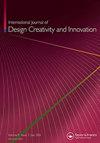The construction of meaning in design-driven projects: a paradox initiated process
IF 2.5
Q4 ENGINEERING, MANUFACTURING
International Journal of Design Creativity and Innovation
Pub Date : 2018-07-27
DOI:10.1080/21650349.2018.1501281
引用次数: 5
Abstract
ABSTRACT In a world of ever-increasing products and services, companies are forced to think differently and find new approaches to bring meaningful and differentiating products to the market. In many cases, they have to go beyond the functional features in order to win the customers’ hearts and attention. Design-driven innovation is acknowledged as a way to create new meaningful experiences to the users – not driven by market demands or technology development but by experience and the emotional parameters of the solution-to-be. Despite an increasing interest in design-driven innovation, the process of how new meanings are constructed is still a neglected area in existing design research. This paper explores how five Danish companies in diverse industries constructed new product meanings. The study indicates that 1) innovation of meaning starts from a paradox in an existing product-user relationship – often experienced by the designer 2) the central point for meanings’ construction is the user’s experience of the product, and 3) meaning is constructed in respect to a number of different product aspects including e.g. experience, interaction and expression.在设计驱动的项目中构建意义:一个悖论引发的过程
在一个产品和服务不断增加的世界里,公司被迫以不同的方式思考,寻找新的方法来为市场带来有意义和差异化的产品。在很多情况下,为了赢得客户的心和关注,他们必须超越功能特征。设计驱动的创新被认为是一种为用户创造新的有意义的体验的方式,它不是由市场需求或技术发展驱动的,而是由体验和未来解决方案的情感参数驱动的。尽管人们对设计驱动的创新越来越感兴趣,但在现有的设计研究中,如何构建新意义的过程仍然是一个被忽视的领域。本文探讨了五家不同行业的丹麦公司如何构建新的产品意义。研究表明:1)意义的创新始于现有产品-用户关系中的一个悖论——这是设计师经常经历的;2)意义构建的中心点是用户对产品的体验;3)意义的构建涉及产品的许多不同方面,例如体验、交互和表达。
本文章由计算机程序翻译,如有差异,请以英文原文为准。
求助全文
约1分钟内获得全文
求助全文
来源期刊

International Journal of Design Creativity and Innovation
ENGINEERING, MANUFACTURING-
CiteScore
3.80
自引率
27.80%
发文量
15
期刊介绍:
The International Journal of Design Creativity and Innovation is an international publication that provides a forum for discussing the nature and potential of creativity and innovation in design from both theoretical and practical perspectives. Design creativity and innovation is truly an interdisciplinary academic research field that will interest and stimulate researchers of engineering design, industrial design, architecture, art, and similar areas. The journal aims to not only promote existing research disciplines but also pioneer a new one that lies in the intermediate area between the domains of systems engineering, information technology, computer science, social science, artificial intelligence, cognitive science, psychology, philosophy, linguistics, and related fields. The journal covers, but is not restricted to, the following topics: ·Theories on Design Creativity and Innovation ·Cognition of Design Creativity ·Innovative Process ·Inventive Process ·Analogical Reasoning for Design Creativity and Innovation ·Design Synthesis ·Method and Tools for Design Creativity and Innovation ·Representation of Design Creativity and Innovation ·Education for Design Creativity and Innovation ·Concept Generation and Inspiration.
 求助内容:
求助内容: 应助结果提醒方式:
应助结果提醒方式:


